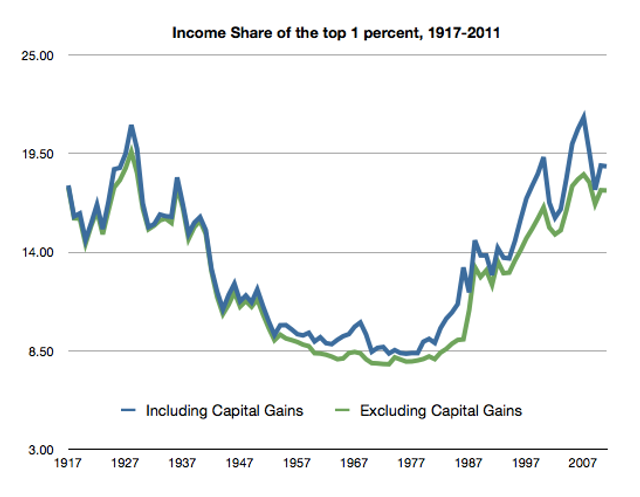Inequality and American Democracy

The latest data on social inequality in the United States, released late last month, provide greater clarity as to what precisely this statement signifies. For Obama and the political establishment as a whole, the main indices of “crisis” are the stock markets, and with them the wealth of the corporate and financial elite.
According to data brought together by University of California’s Emmanuel Saez, between 2009 and 2011—the first two years of the “recovery”—average real income per family grew by 1.7 percent. However, Saez notes, “Top 1 percent incomes grew by 11.2 percent while bottom 99 percent incomes shrunk by 0.4 percent. Hence, the top 1 percent captured 121 percent of the income gains in the first two years of the recovery.”

Saez adds, “In 2012, top 1 percent income will likely surge, due to booming stock-prices, as well as re-timing of income to avoid the higher 2013 top tax rates. Bottom 99 percent will likely grow much more modestly than top 1 percent incomes from 2011 to 2012. This suggests that the Great Recession has only depressed top income shares temporarily and will not undo any of the dramatic increase in top income shares that has taken place since the 1970s.”
These trends in income share are not merely the product of abstract economic forces. They result from a definite and ruthless class policy pursued first by Bush and escalated under Obama. In response to the collapse of 2008, which was the outcome of financial speculation on an historically unprecedented scale, unlimited funds were made available to the banks by the government and Federal Reserve.
To finance the stock market boom, the Fed has purchased some $2 trillion worth of assets since 2008, essentially printing an equal amount of money to transfer into the financial system. Governments internationally have pursued a parallel policy. The results have been predictable: asset bubbles have been reflated, while the bad debts of the financial aristocracy have been transferred to central banks and government budgets.
The corollary to these measures has been a systematic and ongoing attack on the living standards of the vast majority of the population. In his State of the Union address, Obama trumpeted the supposed resurgence of manufacturing jobs—in fact, a tiny minority of those wiped out have been restored. He did not mention that whatever jobs have been created are on the basis of poverty level wages, spearheaded by the administration’s 2009 restructuring of the auto industry.
As a consequence, the number of “working poor” in the United States—those living in near poverty despite being employed—has increased sharply. In 2011, 47.5 million people lived in families earning less than 200 percent of the official poverty rate. This is nearly one third (33 percent) of all working families, up from 31 percent in 2010 and 28 percent in 2007.
These figures do not include the unemployed. Despite the official decline in the unemployment rate, due largely to millions of people leaving the labor force, the overall employment-population ratio remains near its post-crisis low.
Behind the thin rhetoric about reigniting a “thriving middle class,” Obama made clear that the administration’s policies in its second term will be subordinated entirely to the interests of big business, beginning with plans to slash hundreds of billions more from health care programs.
The inequality figures say much about the character of American society—a society dominated by a tiny aristocracy. The program of the political establishment as a whole is above all dedicated to ensuring the wealth of this social layer. It is the conflict between this aristocracy and the working class that forms the fundamental social division, not the various forms of identity politics that have become integral components of state ideology.
These social relations are central to understanding the crisis of American democracy. Without any significant opposition from the media or within the political establishment, the Obama administration has asserted the right to assassinate US citizens without any judicial review or due process.
Core democratic principles going back centuries are simply discarded. After initial media coverage of the administration white paper on the extra-judicial killing of US citizens, the issue has largely been dropped. Obama’s pick to head the CIA, John Brennan, the architect of the “kill lists,” is expected to be confirmed by the Senate later this month.
Under the banner of the “war on terror,” the past decade has seen a relentless expansion of executive power, from indefinite detention and military commissions, to domestic spying and the development of vast databases of communications.
Democratic forms of rule are not compatible with the enormous levels of inequality that pervade American society.
The defense of democracy and opposition to inequality are inextricably connected, and both depend on the development of an independent political movement of the working class in opposition to capitalism, the economic foundation upon which the modern aristocracy rests.

No comments:
Post a Comment